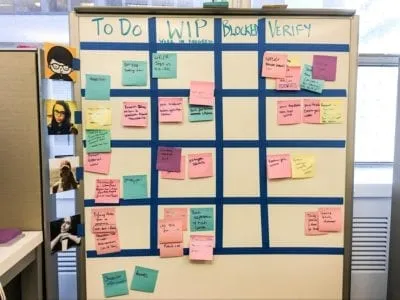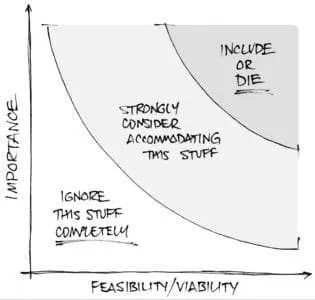If your product suffers from inconsistent behavior or performance, you’ve probably made long-term sacrifices for short-term gains. You’ve accumulated UX debt.
For example, it’s not uncommon for a company to release a “critical mass” of features to gain market share. The team worries first about quick user acquisition, scheduling the cleanup work for later sprints.
When it comes to UX debt, you won’t know all the answers immediately. And you probably won’t fix it all by the next release. But that doesn’t mean you should give up. If you can create a plan that doesn’t give product management a heart attack, you will eventually eliminate your debt.
Roll up your sleeves. We can do this.
Step 1: Create and Validate a UX Debt Inventory
Whether you’re at the receiving end of an incoming product acquisition or joining as a new hire, corralling UX debt starts with discovering what you’re up against. And that means conducting an inventory.
Let me walk you through the process.
First, sit down and use the product. You want to do this yourself to highlight anything you find unintuitive or confusing. Keep notes as you go, or ask someone to write down your comments as you use the product—then switch places.

UX debt spreadsheet used by my team
Another collaboration option entails using a spreadsheet (like this one) in your team’s cloud folder while evaluating the heuristics together. As the creators Susan Rector and Kim Dunwoody suggest, review the system based on criteria in the following categories:
- Findability
- Accessibility
- Clarity of Communication
- Usefulness
- Credibility
- Learnability
- Overall Aesthetics
- Persuasive Design
You can create a solid snapshot of UX gaps by involving the whole team. Completing the evaluation will definitely take more than a week. Be sure to block out a manageable timespan to slowly chip away at it (e.g., 1-2 months).
Remember that while this exercise is highly informative, at the end of the day, you’re not the intended user.
Now that you’ve conducted a UX debt inventory, it’s time to validate your findings by observing and talking with actual users and subject matter experts (read more on that in Rian van der Merwe’s free guide Practical Enterprise User Research).
This will help you better prioritize the work with product managers for the payback sprints or the backlog.
Step 2: Prioritization
Once you’ve revealed all the debt, you must prioritize so that it can be addressed in realistic stages.
Severity & Impact
How big is the issue? Is it keeping users from doing their work? Is it creating a safety or security risk? Is it causing a potential customer to turn around and look to a competitor’s product?
As explained in the free guide Eliminate UX Gaps In Your Product I wrote with UXPin, these are all relatively severe effects that suggest the issue is a high priority.
But don’t just consider the negatives. How big an improvement will the user see? Will the improvement save hours of time in the course of a month? Will it reduce errors? If so, it may be worthy of high prioritization, even if it isn’t currently considered to be a big problem.
If you have a lot of products, you may consider employing a UX Maturity Model as the basis for prioritization.
Estimated Time to Address
How long is it going to take to fix?
If all you have to do is tweak the CSS, you might slip it into the next build. On the other hand, if it’s going to require a significant amount of development or will have to be thoroughly regression tested, it may make sense to hold off until it can be resolved with other issues requiring similar treatment.
Responsible Party
Who will be tasked with addressing the issue?
If it falls primarily on the UX team, and they currently have a light workload, it may be given a high priority. If it requires the attention of a specific developer who is already assigned to other high-priority work, then it will have to wait.
Step 3: Schedule
After prioritizing your debt, the next step is to work with product management to get it into your release schedule.
Agile is so popular these days that it seems like any process that isn’t Agile is labeled “waterfall.” I find that to be a bit dismissive. There are degrees of being Agile, and you can have an effective, iterative process that doesn’t involve stories, scrums, and sprints.
For our purposes, however, I’ll address all non-Agile processes at once. Then I’ll make suggestions for Agile teams.
If You Aren’t Agile
Your work is likely planned based on a release cycle. Your organization decides what will go into the next release based on criteria such as how long the development effort will be; how badly a feature is needed by customers; what will sell; what bugs exist and how bad they are; and so forth.
I recommend handling UX debt issues as bugs. The real benefit of this approach is that debt items can be entered and tracked using the same tools and business processes as bugs. This will ensure that they get reviewed and treated equally. A representative from the UX team on the issue review board should prioritize items, ensuring that usability issues get the full weight they deserve.
Ideally, a representative from the UX team will also work closely with product management when releases are scheduled.
When a particular part of the application is being scheduled for work, check it for UX debt. Would it add much effort to address the debt at the same time? Often, there will be savings simply because the code is already being updated by developers. Even if it’s a low-priority item, take advantage of the opportunity to pay down some debt.
If You Are Agile
A company that employs a healthy Agile process shouldn’t have any problem prioritizing debt with other types of work, assigning it story points, and fitting it into sprints.
Find the rhythm
In my own experience, however, Agile has been embraced as a way to get more work done faster, rather than as a method of iterative improvement.
In such situations, you may have a harder time scheduling UX debt because (as management sees it) there’s not enough time to fit in everything they aim to wrap up, so there certainly isn’t time for all those trivial corrections you’re asking for.

Photo credit: Laura Kershaw. Design process at Kaplan Test Prep for UX Design in Action.
If you find yourself in such an environment, your goal should be to find a rhythm for addressing debt.
Propose a certain number of story points per sprint (or every other sprint). Or, perhaps a sprint could be devoted to addressing debt at some regular interval (payback sprint). This should be done at least until the backlog of historic debt—your debt inventory—has been handled. Then it should become easier to keep up with new debt that crops up without that regular schedule.
Try a “Cheese Day”
For even tighter schedules, consider holding a Cheese Day to knock out as much debt as possible. Management is almost always receptive to a one-day workshop every 60 days where you knock many items off the debt list.
The following procedure suggested by Roy Man is both realistic and effective:
- About 2-4 weeks before Cheese Day, create the project in your app of choice (Asana, Trello, Basecamp, etc) and encourage everyone from customer support to developers and designers to briefly describe product annoyances.
- Prioritize the cheese list based on the advice in the below chart. Separate the “Quick Wins” from the “Nice-to-Haves”.

Photo credit: Joe Natoli
- Schedule 6-8 hours for the Cheese Day, inform everyone of the date, then dive right into the “Quick Wins”. Everyone will feel productive, and you’ll have progress to show management at the end.
Conclusion
Most importantly, we address UX debt through collaboration.
UX debt should be understood as the responsibility of the entire organization—not just the UX group. It takes a good working relationship with your entire team to ensure that UX debt is given the attention it deserves.
And of course, the best way to eliminate UX debt is always avoiding it in the first place.
If you found this article useful, get more advice by downloading the free e-book Eliminate UX Gaps In Your Products.



